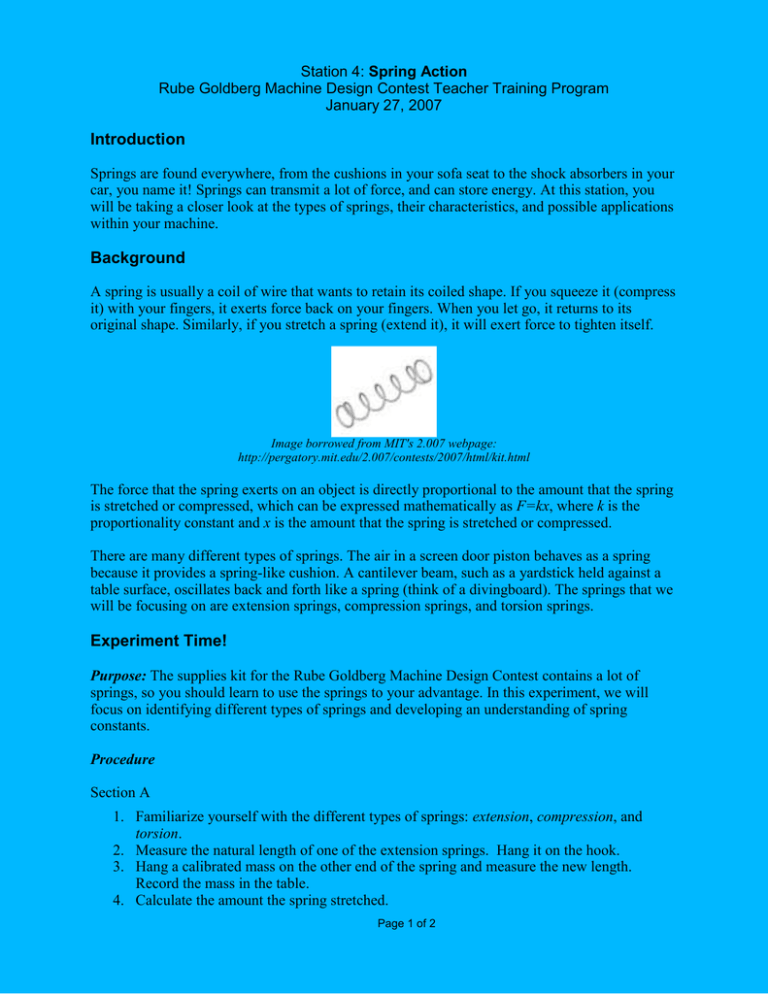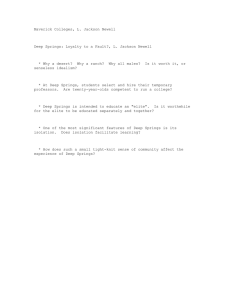- Spring worksheet
advertisement

Station 4: Spring Action Rube Goldberg Machine Design Contest Teacher Training Program January 27, 2007 Introduction Springs are found everywhere, from the cushions in your sofa seat to the shock absorbers in your car, you name it! Springs can transmit a lot of force, and can store energy. At this station, you will be taking a closer look at the types of springs, their characteristics, and possible applications within your machine. Background A spring is usually a coil of wire that wants to retain its coiled shape. If you squeeze it (compress it) with your fingers, it exerts force back on your fingers. When you let go, it returns to its original shape. Similarly, if you stretch a spring (extend it), it will exert force to tighten itself. Image borrowed from MIT's 2.007 webpage: http://pergatory.mit.edu/2.007/contests/2007/html/kit.html The force that the spring exerts on an object is directly proportional to the amount that the spring is stretched or compressed, which can be expressed mathematically as F=kx, where k is the proportionality constant and x is the amount that the spring is stretched or compressed. There are many different types of springs. The air in a screen door piston behaves as a spring because it provides a spring-like cushion. A cantilever beam, such as a yardstick held against a table surface, oscillates back and forth like a spring (think of a divingboard). The springs that we will be focusing on are extension springs, compression springs, and torsion springs. Experiment Time! Purpose: The supplies kit for the Rube Goldberg Machine Design Contest contains a lot of springs, so you should learn to use the springs to your advantage. In this experiment, we will focus on identifying different types of springs and developing an understanding of spring constants. Procedure Section A 1. Familiarize yourself with the different types of springs: extension, compression, and torsion. 2. Measure the natural length of one of the extension springs. Hang it on the hook. 3. Hang a calibrated mass on the other end of the spring and measure the new length. Record the mass in the table. 4. Calculate the amount the spring stretched. Page 1 of 2 5. Apply Hooke's law (F=kx) to determine the spring constant k. 6. Repeat steps 2-5 for two more extension springs. What is the relationship between k and the stiffness of the spring? Weight (N) Natural Length (m) Extended Length (m) Difference (m) Spring Constant (N/m) Trial 1 Trial 2 Trial 3 Section B 7. Choose a compression spring and a weight. 8. Measure the natural length of the spring in meters. Put the weight on the platform atop the compression spring and measure the new length. Record the length measurements and the mass in the table. 9. Put another calibrated mass on the platform and measure the new length. Record mass and new length values in second row in the table. 10. Repeat for a one other mass. Calculate the spring constant. What’s the relationship between the spring constant, the spring length change, and the mass (i.e. force applied)? Weight (N) Natural Length (m) Compressed Length (m) Page 2 of 2 Difference (m) Spring Constant (N/m)


